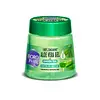What's inside
What's inside
 Key Ingredients
Key Ingredients

No key ingredients
 Benefits
Benefits

 Concerns
Concerns

 Ingredients Side-by-side
Ingredients Side-by-side

Water
Skin ConditioningPropylene Glycol
HumectantNiacinamide
SmoothingPEG-12 Dimethicone
Skin ConditioningCarbomer
Emulsion StabilisingAloe Barbadensis Leaf Extract
EmollientOcimum Sanctum Leaf Extract
Skin ConditioningAzadirachta Indica Leaf Extract
Skin ConditioningCitrus Medica Limonum Peel Extract
EmollientCamellia Sinensis Leaf Extract
AntimicrobialSalicylic Acid 0.7%
MaskingTocopheryl Acetate
AntioxidantPEG-40 Hydrogenated Castor Oil
EmulsifyingDisodium EDTA
DMDM Hydantoin
PreservativePhenoxyethanol
PreservativeSodium Benzotriazolyl Butylphenol Sulfonate
UV AbsorberButeth-3
SolventTributyl Citrate
SolventSodium Hydroxide
BufferingParfum
MaskingCI 42090
Cosmetic ColorantCI 47005
Cosmetic ColorantWater, Propylene Glycol, Niacinamide, PEG-12 Dimethicone, Carbomer, Aloe Barbadensis Leaf Extract, Ocimum Sanctum Leaf Extract, Azadirachta Indica Leaf Extract, Citrus Medica Limonum Peel Extract, Camellia Sinensis Leaf Extract, Salicylic Acid 0.7%, Tocopheryl Acetate, PEG-40 Hydrogenated Castor Oil, Disodium EDTA, DMDM Hydantoin, Phenoxyethanol, Sodium Benzotriazolyl Butylphenol Sulfonate, Buteth-3, Tributyl Citrate, Sodium Hydroxide, Parfum, CI 42090, CI 47005
Ingredients Explained
These ingredients are found in both products.
Ingredients higher up in an ingredient list are typically present in a larger amount.
Parfum is a catch-all term for an ingredient or more that is used to give a scent to products.
Also called "fragrance", this ingredient can be a blend of hundreds of chemicals or plant oils. This means every product with "fragrance" or "parfum" in the ingredients list is a different mixture.
For instance, Habanolide is a proprietary trade name for a specific aroma chemical. When used as a fragrance ingredient in cosmetics, most aroma chemicals fall under the broad labeling category of “FRAGRANCE” or “PARFUM” according to EU and US regulations.
The term 'parfum' or 'fragrance' is not regulated in many countries. In many cases, it is up to the brand to define this term.
For instance, many brands choose to label themselves as "fragrance-free" because they are not using synthetic fragrances. However, their products may still contain ingredients such as essential oils that are considered a fragrance by INCI standards.
One example is Calendula flower extract. Calendula is an essential oil that still imparts a scent or 'fragrance'.
Depending on the blend, the ingredients in the mixture can cause allergies and sensitivities on the skin. Some ingredients that are known EU allergens include linalool and citronellol.
Parfum can also be used to mask or cover an unpleasant scent.
The bottom line is: not all fragrances/parfum/ingredients are created equally. If you are worried about fragrances, we recommend taking a closer look at an ingredient. And of course, we always recommend speaking with a professional.
Learn more about Parfum